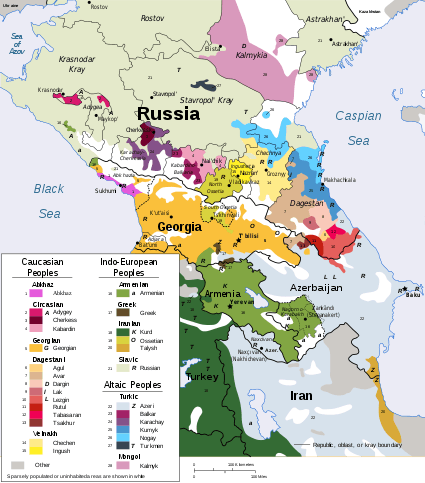Cherkess
| Адыгэ | |
|---|---|
| Total population | |
| (49,591 people) | |
| Regions with significant populations | |
| 73,184[1] | |
| Languages | |
|
Cherkess (Kabardian) Russian | |
| Religion | |
| Sunni Islam | |
| Related ethnic groups | |
| Other Circassians | |
Cherkess or Cherkes (Russian: Черкесы Čerkesy; Adyghe: Чэркэс, Шэрджэс Šerdžes) is a term derived from the Russian language name for the Circassians, a people of the North Caucasus.[2] While the term was traditionally applied to all Circassians before Soviet times, it has since usually referred only to the Circassians living in northern Karachay-Cherkessia,[2] a federal subject of Russia where they are indigenous and formed just under 12% of the population in 2010.[3] These Circassians are mostly Besleney Kabardians who speak the Cherkess, i.e. Circassian, language.[4] They also inhabit the villages of Khodz, Blechepsin, Koshekhabl, and Ulyap in nearby Adygeya.
The Cherkess generally call themselves Adyge (Адыгэ) as do most Circassians.[2] The name of the Cherkess was given to Cherkessk, formerly called Batalpashinskaya, the capital of Karachay-Cherkessia.
History
The Cherkess (in the narrow sense) migrated from Kabarda between 1780–1825, settling in the upper Zelenchuks and Urup valleys, from which they were largely displaced during the period of the 1830–1850s. During the 19th century, due to pressure from the Russia, many Cherkess moved to the Middle Eastern countries, where they largely assimilated, while still living there as a distinguishable minority. Most Cherkess have converted to Islam.
The political history of the Cherkess since the Russian Revolutions of 1917 is complex. A Karachay-Cherkess Autonomous Oblast was created on 12 January 1922. It was split into Karachay Autonomous Oblast and Cherkess National Okrug on 26 April 1926. The Cherkess National District was elevated to an autonomous oblast status on 30 April 1928. This Cherkess Autonomous Oblast existed until 9 January 1957, when it was incorporated into the Karachay-Cherkess Autonomous Oblast in its former borders following the rehabilitation of the Karachay (whom Stalin had had deported to Central Asia in 1943).
On 3 July 1991, the autonomous oblast was elevated to the status of the Autonomous Soviet Socialist Republic of Karachay-Cherkessia (under the jurisdiction of the Russian SFSR). With the dissolution of the Soviet Union in December 1991, the various peoples of Karachay-Cherkessia proclaimed their own polities including, on 27 October 1991, the Cherkessia Republic. Russia was prepared to accept division of the territory, but a 28 March 1992 referendum saw a majority of the population vote against separation, and on 9 December 1992, the words "Autonomous Soviet Socialist" was dropped from the name and it became the Karachay-Cherkess Republic.[5]
References
- ↑ Russian Census 2010: Population by ethnicity Archived April 24, 2012, at the Wayback Machine. (Russian)
- 1 2 3 James Stuart Olson, et al., eds. "Cherkess".An Ethnohistorical Dictionary of the Russian and Soviet Empires. Greenwood Publishing, 1994. p. 150. ISBN 9780313274978 "The Beslenei (Beslenej) are located between the upper Urup and Khozdya rivers, and along the Middle Laba River, in the western reaches of the North Caucasus."
- ↑ http://www.gks.ru/free_doc/new_site/perepis2010/perepis_itogi1612.htm (Russian)
- ↑ Всероссийская перепись 2010, Итоги, Т. 4. — Табл. 1. Национальный состав населения (скачать: ).
- ↑ Закон РФ от 9 декабря 1992 г. N 4061-I «Об изменениях и дополнениях Конституции (Основного Закона) Российской Федерации — России» (принят седьмым Съездом народных депутатов РФ) (Russian)

